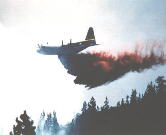 Service
of AFIA
Service
of AFIA
 New
technology, new techniques and new technicians have over the years, changed
the business of fighting wildland fires with airtankers. The result has
been a nationwide aerial firefighting discipline that is both cost-effective
and extremely capable. Within the ranks of the Aerial Firefighting Industry
Association (AFIA), an organization comprised of 14 commercial airtanker
companies and seven sustaining member companies involved in all areas of
aerial firefighting, there is a unique fleet of carefully maintained airtankers
and skilled pilots.
New
technology, new techniques and new technicians have over the years, changed
the business of fighting wildland fires with airtankers. The result has
been a nationwide aerial firefighting discipline that is both cost-effective
and extremely capable. Within the ranks of the Aerial Firefighting Industry
Association (AFIA), an organization comprised of 14 commercial airtanker
companies and seven sustaining member companies involved in all areas of
aerial firefighting, there is a unique fleet of carefully maintained airtankers
and skilled pilots.
Early Airtanker Development
The first practical deployment of aircraft to fight fires came in the mid-fifties when the State of California and the U. S. Department of Agriculture-Forest Service began working together on a joint airtanker program. The initial aircraft of choice were World War II vintage Stearman PT-17s and N3N biplanes, which are far removed from the airtankers and technologically advanced delivery systems used by today's AFIA pilots.
During the development of the airtanker industry, surplus military aircraft were popular for conversion to airtankers for many reasons, some of which include:
The Pilots of AFIA
There never has been anything that could improve upon the human element of courage and excellence that always have been and always be at the heart of aerial firefighting. The pilots of AFIA fly through gullies, over mountains and in other hazardous places under some of the most perilous conditions.
To get an idea of what it's like to fly in the thick of a forest fire, consider what Dave Kelly told AG-Pilot International. "You're listening to at least two radios at a time, talking to other pilots and the people on the ground. You're operating the flaps, setting up the drop systems and you keep changing the power as you need to. We have to drop at about 150 feet above the terrain and we're flying nose-to-tail with the lead pilot, so you have to be careful you don't run over him." By nature, a firefighting mission is supported by an elaborate strategy, but as one pilot said, "On a big fire, there is not much opportunity to plan ahead." More aptly, it is an exercise in seat-of-the-pants flying where the main objective is to keep focused on your mission-even while the temperature in the cockpit registers 150 degrees at times.
Adding to the difficulty of the job is the fact that pilots often do not know when or how frequently they will be called upon in any given year. These pilots, however, are extremely dedicated - each having at least 1,500 hours of flight time and experience flying at low levels. In fact, most of the captains in the multi-engine airtanker ranks have been fighting fires for more than 20 years.
 Service
of AFIA
Service
of AFIA
The 14 commercial airtanker companies own and operate more than 75 multi-engine, heli and single-engine airtankers. They provide aerial firefighting services to all regions of the United States during the peak fire season. They also remain in an "on-call availability status" at their home bases for periods of time before and after the peak fire season in the event of an early or extended season. The typical fire season ranges from February through October. The private companies that make up AFIA account for 85% of multi-engine airtankers available throughout private industry and 91% of federally contracted multi-engine airtankers. AFIA companies provide the best value to the federal government in aerial firefighting services, and continue to improve their capabilities through internal company research and development programs focused on fielding improved airtankers and delivery systems.
Large Airtanker Program Cost-Benefit
A 1996 National Airtanker Study conducted by the U. S. Department of Agriculture-Forest Service and Department of Interior validated the effectiveness of the 1995 large airtanker program as follows: "The benefit to airtanker program cost ratio of this 1995 large airtanker program is ($96,891,948/$11,192,024) or 8.7 to 1. This benefit cost is to the initial attack program. Additional benefits can be attained in the support of large fire suppression."
The Future of AFIA
As aerial firefighting continues to evolve, more changes are occurring and more are in store. The 1996 National Airtanker Study validated the need for 41 large airtanker contracts annually and recommended a future large airtanker fleet composed of 41 large, commercially operated, turbine powered airtankers with varied tank capacities. This all turbine fleet will provide a retardant deliver capability of thirty 3000-gallon airtankers and eleven 4000+-gallon airtankers. The estimated cost-benefit upon full implementation of the recommendation was 6.38:1. However, due to a Forest Service decision to ground the C-130A and PB4Y airtankers following the loss of a C-130A and PB4Y because of structural failures, the modernization of the large multi-engine airtanker fleet has taken on a new urgency and new direction. Turbine aircraft continue to be desired but the make-up of the fleet has yet to be determined. Regardless of the types of aircraft chosen, they will have to undergo rigorous testing and inspections to ensure they are capable of operating in the challenging aerial firefighting environment.
The timely modernization of the commercial aerial firefighting is strongly
dependent upon a spirit of private and public collaboration in which agreements
can be forged on realistic time schedules and cost reimbursements.